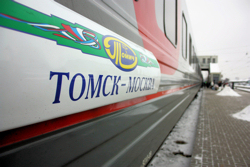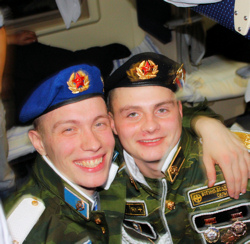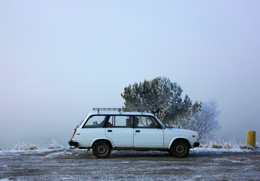Russia by train: A journey aboard the Trans-Siberian
Making friends on the Trans-Siberian is easy, it’s staying sober that’s the hard part. Gavin Haines travels the most iconic railway line in the world.
Between sips of vodka, Boris the pie-eyed Russian repeated the only conversational English he knew: “I love Beatles”. He serenaded me with Let It Be. I started a rendition of Back In The USSR – he didn’t join in.
 All aboard! The Trans-Siberian is the world's most iconic railway
All aboard! The Trans-Siberian is the world's most iconic railwayWTG / Gavin Haines
This easy-on-the-eye vista belied the harsh reality on the other side of the window. Even the trees could barely cope with the Siberian winter; the small, spindly things were stunted by the cold and if you looked closely you could almost see them shivering.
Occasionally, as we scythed through the countryside, the snow sparkling in the winter sun, we passed a town. From the warmth and comfort of the carriage it was hard to believe people lived in these middle-of-nowhere communities. The small, frozen settlements seemed like a million miles away from bustling Moscow, let alone Britain.
Smoke rose from the chimneys of wooden houses, the residents inside being held hostage by the cold. It was bleak but beautiful.
Making friends
 Siberia is a wintry wonder
Siberia is a wintry wonderWTG / Gavin Haines
If you want to be a hit on the Trans-Siberian, bring some edible treats from home to share with passengers. They love exciting foreign snacks nearly as much as they love sharing their food with you.
Learn a bit of Russian too, it’ll go a long way. I didn’t bother and spent many an arduous hour thumbing through a phrasebook trying to find out more about passengers.
My biggest curiosity was where all these people were going. And why? I discovered most people were visiting family or going to find work. They wanted to know what I was doing here. “A holiday,” I explained. They frowned, looked at the endless, frozen landscape and shook their heads.
The dining cart
 Get merry with the Russian military
Get merry with the Russian militaryWTG / Gavin Haines
It was in the dining cart I met Boris. The vodka-pickled and increasingly vociferous Beatles fan had murdered one too many classics for some and was soon given his marching orders by a passenger who looked like he could have been kicked out of the Red Army for being too mean.
Turns out this rough diamond was a lawyer, fluent in English and an all-round good egg. As the sun abandoned Siberia, we drank beer and recruited a motley crew of passengers to play cards with.
The Russians might not be renowned for their hospitality, but these guys (always men) couldn’t have been more welcoming. Yes, it looked like a net had been cast over a prison and this group of bruisers was the catch, but they were gracious; offering me their beer, vodka and dried fish.
As the train disappeared into the night, we made shots of vodka vanish and played curious Russian card games that still remain a mystery to me. Not for the last time, I staggered back to my bed, knocking my head on people’s feet as I went.
I woke mid-morning with a thumping headache. The scenery hadn’t changed a bit.
Sleeping – it’s a class thing
 Hardy Ladas are a common sight
Hardy Ladas are a common sightWTG / Gavin Haines
The industrious carriage attendants keep the modern carriages shipshape and providing you’ve got a pair of earplugs you’ll sleep soundly. If you get a bottom bunk (the cheapest option) then people will sit on your bed during the day; that’s just how it works, so top bunks are probably best if you want a siesta, which I did after a night in the dining cart.
Of course you could always get a private cabin, where you can hide away from fellow passengers but you’ll be missing out on the whole experience. It’s called first class and it costs a fortune.
Or, if you’re sociable but a bit shy, you could get a bed in a four-birth cabin. They are reasonably priced but if you happen to be sharing with some dullards or, worse still, nutters, you’re stuck with ‘em.
Whatever option you choose you’ll get clean sheets, a comfortable bed and a wake-up call when it’s your stop.
Where to stop
 Bleak but beautiful, Lake Baikal is a popular stop-off
Bleak but beautiful, Lake Baikal is a popular stop-offHemera / Thinkstock
So the wooden architecture, quaint atmosphere and local markets of Tomsk are something of a reprieve from this and definitely worth checking out for a few days.
And don’t miss beautiful Lake Baikal, the deepest freshwater lake on the planet. It’s the size of Belgium, home to the only freshwater seals in the world and, if you visit in the depths of winter, you can walk on the frozen surface and see 40m (131ft) below.
Aside from its power station billowing out smoke, Ulan-Ude is a fairly charming university city. It’s the blurred boundary between Russia and Central Asia, which shows in the features of its inhabitants. Famous for the giant Lenin head in the centre of town, Ulan-Ude is also the place to peel off for the Trans-Mongolian... but that’s a yarn for another day.
The details…
Buying tickets
 Travel in winter to get discount tickets
Travel in winter to get discount ticketsCreative Commons / yeowatzup
If you’re likely to get stressed out thumbing through phrasebooks at ticket kiosks, pay someone else to get your tickets. Look online - www.russiantrains.com or www.trainsrussia.com are both good, or find a travel agent in Moscow. It’s hassle-free but more expensive.
Alternatively, brave the kiosks and sort the whole trip yourself. Your labours will be rewarded by huge financial savings. You’ll need a note in Russian explaining where, when and what class you want to travel, not to mention patience; kiosks are mobbed and few of the tellers speak English.
Ticket prices vary significantly depending on what time of the year you travel. There are significant discounts during the winter, which is how I got between Moscow and Beijing for under £300.
Quick Trans-Siberian facts
• The Trans-Siberian Express runs across Russia from Moscow to Vladivostok. At just over 9,200km (5,717 miles), it is the longest train journey in the world and takes nearly seven days.
• The Trans-Siberian covers nine time zones but all trains run on Moscow time.
Do you have any Feedback about this page?
© 2025 Columbus Travel Media Ltd. All rights reserved. No part of this site may be reproduced without our written permission, click here for information on Columbus Content Solutions.









 You know where
You know where